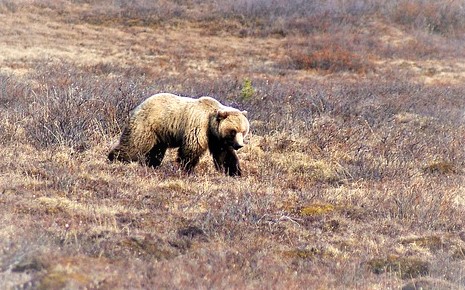by Staff
Mountain States Legal Foundation
The Grizzly Wars: Environmentalists at War with Science and Ranchers Over Bear Management
Wyoming ranch hand Marcelo Tejeda was tending sheep in Wyoming’s Upper Green River Valley. He was settling down for the night when suddenly the still, quiet air of the Wyoming wild was shattered by a dog’s shrill bark. Marcelo knew by the sound of the bark that something was wrong. It could be those troublesome coyotes again, or even a wolf. He left his tent and ran toward the sound. What he discovered chilled him — a group of grizzly bears, ravaging the sheep.
In the dim glow of his flashlight, Marcelo saw a nightmare scene of teeth, claws, and blood, surrounded by a hundred miles of darkness in every direction. A grizzly locked eyes on him. Marcelo began to back away but the grizzly charged. Marcelo turned and ran for his life. But he didn’t get far. The bear caught him from behind and attacked, leaving numerous punctures in his chest, slashes across his abdomen, and a seven-inch gash across his head. Two cans of bear spray were not enough to stop the bear’s attack. Marcelo was mauled to the brink of death, while the dog continued barking helplessly nearby.
Marcelo was airlifted to a hospital in Idaho Falls, where surgeons ultimately saved his life. But today he knows of how close he came to dying that night. Marcelo, and other ranchers and sheepherders like him face these kinds of dangers nearly every day out on the range. And they know the danger is increasing with each passing year, as the grizzly population in the area explodes.
Wyoming ranchers have made many efforts to mitigate the dangers to humans and livestock, and to try to live peacefully with the grizzlies. Mary “Mickey” Thoman, who operates W&M Thoman Ranches, where Marcelo worked when he was attacked, purchased electric fences to guard her sheep by night. Yet often, when sheepherders released the sheep to graze in the morning, they would see grizzlies gathering nearby, waiting for their chance to attack. They observed as many as a dozen grizzlies in one grazing area.
As the grizzly population grew, the livestock losses became unbearable. Mickey lost hundreds of ewes and lambs, whom the grizzlies would leave scattered and bloodied on a hillside, often not eating them but killing for sport. Mickey is a great-grandmother, and her family has been raising sheep in this part of Wyoming for more than 100 years. She was eventually forced to make the heartbreaking decision to give up her family’s historic grazing lands.
Because the grizzly is listed as a protected species under the Endangered Species Act, ranchers can face enormous fines or even prison time if they shoot and kill a grizzly in self-defense. They have no way to protect themselves, and no choice but to leave the land they love behind. Grizzlies now run unchecked over the land Mickey and other ranching families once safely roamed.
Mickey and other Wyoming ranchers were relieved when scientists and officials with the U.S. Fish and Wildlife Service determined that the grizzly population in the Greater Yellowstone Area had met its population goals. The species was fully recovered, and officials recommended that the grizzly be removed from the Endangered Species list. That would enable ranchers to safely defend themselves in the event of an attack, without fear of jail time. More importantly, it would allow local wildlife management officials to relocate grizzlies to less populated areas, where they would be far less likely to encounter humans in the first place. The decision to delist the grizzly was good news for the bears too, because it meant the population had recovered.
Yet as soon as Fish and Wildlife officials made the decision to delist the grizzly, an army of lawyers backed by extreme environmentalist organizations stepped in and convinced a federal judge to put the grizzly back on the endangered list, contradicting the advice of Fish and Wildlife experts.

On their own, ranchers like Mickey Thoman had no way to fight the army of big city lawyers the environmental extremists had on their side. Mountain States Legal Foundation attorneys stepped in to represent her and other ranchers free of charge in the case, Crow Indian Tribe v. United States. The ranchers were desperate to be allowed to defend themselves against an attack, and hopeful that wildlife officials could finally relocate the predators to less populated areas. The ranchers knew their livelihoods, and even their lives, depended on it.
“I pray that justice will prevail,” Mickey Thoman said at the time.
But the federal judge in the case sided with the environmental extremists. MSLF attorneys appealed and have vowed not to stop fighting on for Mickey and other Wyoming ranchers in the same plight. Meanwhile, the environmentalist lawyers have taken their fight against western ranchers even further. Building upon their victory in the first grizzly case, they have now filed a new lawsuit, Center for Biological Diversity v. Bernhardt, which threatens to put Western states’ ranchers and farmers out of business for good.
You may also like
-
Foot deformities in Texas foals caused by effects of nearby wind turbines
-
Arizona rancher sues to stop million-acre national monument
-
VDH: How to Destroy the American Legal System
-
Bob West: Facing the reality of wolves, Colorado ranchers need to be prepared
-
Study debunks simplistic idea that wolves fix ecosystems


, an army of lawyers backed by extreme environmentalist organizations stepped in and convinced a federal judge to put the grizzly back on the endangered list
gee. I wonder how they did that? cash? physical threats, extortion?
The Judge should be investigated.
Bait and poison the bears.
Packs of bears are way dangerous.